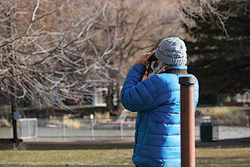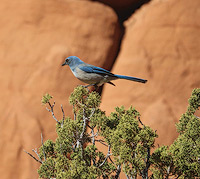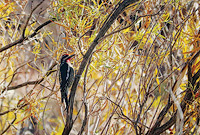 This year marks the 124th annual Christmas Bird Count (CBC). This long-standing citizen science endeavor provides a snapshot of winter bird populations. This free and festive event relies on volunteer birders, from novice to expert, to scour neighborhoods, farmlands, parks, and backyards to count wintering avian wildlife.
This year marks the 124th annual Christmas Bird Count (CBC). This long-standing citizen science endeavor provides a snapshot of winter bird populations. This free and festive event relies on volunteer birders, from novice to expert, to scour neighborhoods, farmlands, parks, and backyards to count wintering avian wildlife.
In 1900, Frank Chapman, an ornithologist and officer of the fledging Audubon Society and others, developed the Christmas Bird Census as an alternative way to connect to nature during the holidays. Twenty-seven participants counted birds in places such as Pacific Grove, California and Toronto, Canada that first year. The total species number for all the counts: 90 birds.
From these humble beginnings, the Christmas Bird Count hatched.
In 2022, 2621 counts occurred in North America, Latin America, and the Caribbean. Over 76,000 people participated and recorded over 40 million birds comprised of 2554 species and numerous hybrids.
Last year, the Moab CBC had 62 participants and counted 63 species. Some of the birds, such as white-breasted nuthatches and white-crowned sparrows, were only counted during the count week – the three days before and after the official count day. Highlighted species included wood ducks, merlin, hooded mergansers, bald and golden eagles, white-winged doves, prairie falcon, and a lone northern pygmy owl. 
This year’s count will take place on December 16. Count coordinator Marcy Hafner (marcymoab@yahoo.com) will once again assign teams to explore sections of the count circle, a 15-mile diameter circle centered near Coffee Pot Rock, which includes Moab Valley, Spanish Valley out to Ken’s Lake, the River Road, Castle Valley, and the Sand Flats area.
Feeder watchers can also participate by submitting counts of birds that visit their backyard feeders. Nothing like enjoying birds from the comfort of your home! For those planning on conducting these counts, it is a good idea to stock those feeders the week prior so birds know where to forage, and to fill bird baths to provide a reliable source of drinking and bathing water.
On count day, teams will assemble at various locations, then head out into their sectors to count birds. It is a good idea to designate someone as the recorder, to keep track of species and numbers of birds observed. Of course, this task can be shared amongst the group and using the eBird app is a good alternative to keep track of the birds especially if rain or snow will result in a soggy paper form.
Though the count occurs all day, groups may choose to bird for part of the day or take a lunch break. The data forms have entries for time and miles spent walking or driving in the effort. Binoculars are essential and a spotting scope, if available, is handy for viewing far off birds. 
Post count, Hafner will tally the numbers and submit the data to the National Audubon Society who organizes the CBC. Some years a potluck brunch is held on the next day to review the counts, check off the highlights, and concentrate on finding missed birds during the remainder of count week.
The count data is available to anyone and researchers use the information to look at winter population trends which may reveal declines in bird populations or unusual seasonal movements which may be due to factors such as climate change or habitat loss.
So, sign up with Marcy and organize some of your birdy friends and family to contribute to better understanding and caring for our feathered friends, the birds, and enjoy the fun day for the birds!
And be sure to mention you read about the Annual Christmas Bird Count in Moab Happenings.